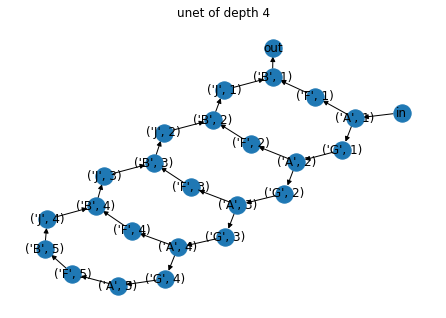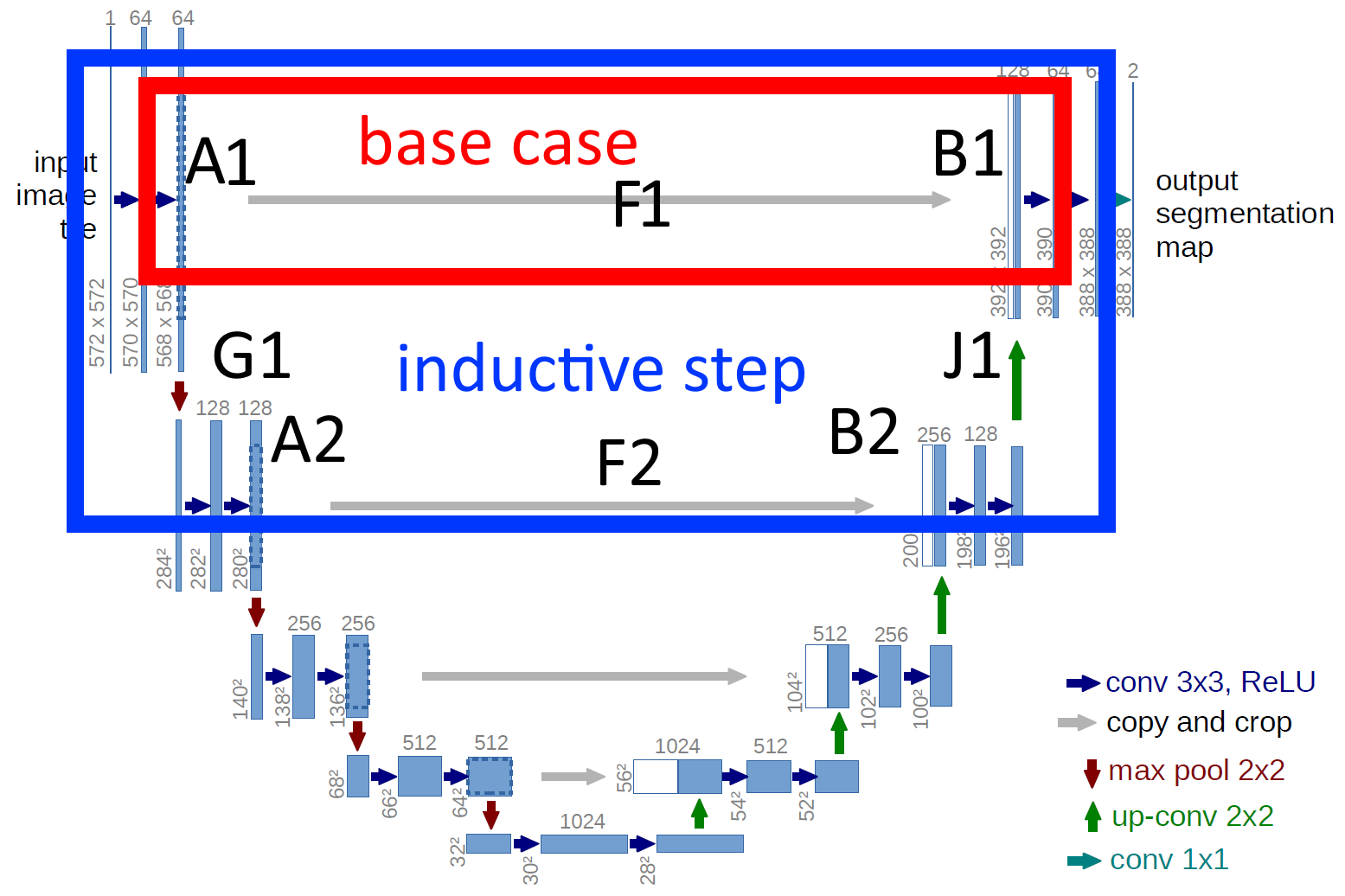The syntax is quite similar to a subset of mermaid.js, with one additional constraint:
- nodes must be of the form
<variable>_<n>
Then you provide diagrams for the base case and the inductive step and specify how many times to apply the inductive step.
unet is basically a base case + an inductive step
base case:
a1 ---f1---> b1
inductive step:
a1 -------f1------ > b1
\ ^
\ g1 j1/
\>a2 ---f2--> b2/
define it as a pair of mermaidjs-esque-syntax diagrams:
base_case = """
%% comments begin with double percents
graph LR
A_1 --> F_1 %% enc conv -> copy and crop
F_1 --> B_1 %% copy and crop -> dec conv
"""
inductive_step = """
graph LR
A_1 --> G_1 %% enc conv -> maxpool
G_1 --> A_2 %% maxpool -> enc conv
A_2 --> F_2 %% enc conv -> copy and crop
F_2 --> B_2 %% copy and crop -> dec conv
B_2 --> J_1 %% dec conv -> up conv
J_1 --> B_1 %% up conv -> dec conv
"""
To parse + interpret this structure:
from interpret import DslInterpreter
unet_4 = DslInterpreter().apply(base_case, inductive_step, times=4)
G = nx.DiGraph()
for statement in unet_4:
G.add_edge(statement[0], statement[1])
G.add_edge("in", ("A", 1))
G.add_edge(("B", 1), "out")
pos = nx.kamada_kawai_layout(G)
nx.draw(G, pos, with_labels=True)
labels = nx.get_edge_attributes(G, 'label')
nx.draw_networkx_edge_labels(G, pos, edge_labels=labels)
plt.title("unet of depth 4")
plt.show()
which yields
Simple!
base case
graph LR
A_1 --> F_1 %% enc conv -> copy and crop
F_1 --> B_1 %% copy and crop -> dec conv
graph LR
A_1 --> F_1 %% enc conv -> copy and crop
F_1 --> B_1 %% copy and crop -> dec conv
inductive step
graph LR
A_1 --> G_1 %% enc conv -> maxpool
G_1 --> A_2 %% maxpool -> enc conv
A_2 --> F_2 %% enc conv -> copy and crop
F_2 --> B_2 %% copy and crop -> dec conv
B_2 --> J_1 %% dec conv -> up conv
J_1 --> B_1 %% up conv -> dec conv
graph LR
A_1 --> G_1 %% enc conv -> maxpool
G_1 --> A_2 %% maxpool -> enc conv
A_2 --> F_2 %% enc conv -> copy and crop
F_2 --> B_2 %% copy and crop -> dec conv
B_2 --> J_1 %% dec conv -> up conv
J_1 --> B_1 %% up conv -> dec conv
this part not implemented yet
To make the full module, you just provide 2 dicts of higher-order functions that define
- constructors for the modules
- the forward pass definitions
Constructors return a function, i.e. module_n = construct(n)().
Continuing with the unet example, the a modules correspond to the convolutions that multiply the channels:
# enc conv
def mk_a(n):
base_dim = 64
def a_maker():
n_in = base_dim // (2**(n-1))
n_out = base_dim // (2**n)
return nn.Sequential(
nn.Conv2d(n_in, n_out, kernel=3, padding='same'),
nn.BatchNorm2d(out_channels)
nn.ReLU(),
nn.Conv2d(n_in, n_out, kernel=3, padding='same'),
)
return a_maker constructors = {
'a': mk_a,
'b': mk_b,
'f': lambda n: nn.Identity, # copy and crop is not really a module - it can be defined all in the forward pass
...,
}Dict of higher order functions that produce functions that
- accept kwargs of inputs
- return a dict of outputs
A few attributes will be added to the function:
.n: the index, e.g.a_n(3).n = 3.self: the constructed module.variables: a dict for mapping variables of indexes to the actual number in this specific fwd pass (see below for more details)
e.g.
def fwd_a(n):
def a_n(g_n):
h = a_n.self(g_n)
return {"f_n": h, "g_n": h} # routing multiple outputs
return a_n
def fwd_b(n):
def b_n(f_n, j_n): # taking multiple inputs
h = a_n.self(f_n + j_n)
return {"j_n": h}
return b_n
def fwd_f(n):
# copy and crop after considering padding loss
# these calculations effectively get precomputed!
size_a = 572
padding_loss = 4
for _ in range(n):
size_a //= 2
size_a -= padding_loss
size_b = size_a * 2
crop_w = crop_h = size_b
a_center = size_a // 2
a_x0, a_x1 = a_center - crop_w // 2, a_center + crop_w // 2
a_y0, a_y1 = a_center - crop_h // 2, a_center + crop_h // 2
def f_n(a_n):
return a_n[:, :, a_y0:a_y1, a_x0:a_x1]
return f_neg for the in and out nodes
# imagine 'in' were not a python reserved keyword for this illustration..
# a_1(in=...) -> {"f_n": ..., "g_n": ..., }
def a_1(in):
h = a_1.self(in)
return {"f_n": h, "g_n": h}
# b_1(j_n=...) -> {"out": ...}
def b_1(j_n):
return {"out": b_1.self(j_n)}
fwds = {
'a_1': lambda n: a_1
'a': fwd_a,
'b_1': lambda n: b_1
'b': fwd_b,
'f': fwd_f,
...
}If you need to distinguish multiple inputs of the same kind of var e.g.
c_3(c_1=..., c_2=...,)
then just make sure the kwargs use different letters for the variable names after the underscore;
c_n(c_i=..., c_j=...)
The mapping from kwarg name -> variable number will be available to the function as an attribute, e.g.
def fwd_c(n):
def c_n(c_i, c_j):
print(c_n.self.variables['c_i'], c_n.self.variables['c_j'])
return c_n
# then later
fwds = {
...,
'c': fwd_c,
...,
}
# c_3 forward prints "1 2"
